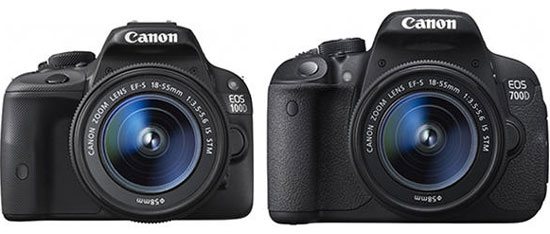Canon announced two new DSLRs immediately prior to Easter, the EOS 100D and EOS 700D.

Both models are due to go on sale this month, with the EOS 100D appearing mid-month and the 700D following towards the end of the month. Canon does not provide RRPs to the media. Advertised pre-order local prices vary, with DCW promoting the 100D body only at $754 and Ted’s at $799. The 700D is $841 body only at DCW and $899 at Ted’s. US suggested prices are US$649 for the 100D and US$749 for the 700D.
The EOS 100D is currently the smallest and lightest DSLR in Canon’s range and one of the smallest and lightest on the current market. It weighs around 400 grams, and has has the same 18-megapixel sensor as the EOS 650D and EOS M cameras.
The 100D will be positioned near the top of Canon’s entry-level DSLR range between the EOS 600D (which currently sells for around $455 for body only) and the new EOS 700D, which replaces the 650D (currently on sale at around $760).
The EOS 700D is positioned as an entry-level DSLR that novice users can ‘grow into’. Accordingly, it offers the manual shooting modes serious enthusiasts require, augmented with creative functions to help beginning photographers. The camera body looks similar to the EOS 650D but has a new textured coating that makes it feel more comfortable to hold and operate.
The mode dial on the top panel has been re-designed to make it more comfortable to use but, as usual, it is split between the Basic and Creative zones. The mode dial rotates through 360 degrees in click-stops to make it easier to move between settings.
In the Basic zone are the Full Auto, Creative Auto and scene preset settings, which have been refined in the latest camera. The Creative Zone contains the P, Tv, Av and M settings required by photo enthusiasts.
Like its predecessor, the EOS 650D, the 700D has a vari-angle monitor with a touch-screen interface. It also supports sensitivity settings up to ISO 25,600 and continuous shooting at up to five frames/second.
The AF system is the most advanced in Canon’s entry-level DSLRs with cross-type sensors used for all nine AF points. Hybrid CMOS AF carries over from the 650D for smooth live view shooting. A new Movie Servo AF function locks onto and smoothly tracks a subject to keep it focused.
The 700D also includes seven Creative Filters (Art Bold, Toy Camera, Water Painting, Miniature, Grainy BW, Fish-eye and Soft Focus), which can be pre-viewed before shooting, enabling users to decide which adjustments to apply. Wireless flash support allows the built-in flash to control external flash guns for complex lighting set-ups.
New lens
Released concurrently with the EOS 100D and EOS 700D is a new EF-S 18-55mm f3.5-5.6 IS STM lens, which features a lead screw type drive for silent and smooth AF. Built-in image stabilisation can reduce blur caused by camera shake by the equivalent of up to four f-stops for handheld photography.
The new lens features an inner focusing mechanism, fast CPU and optimised AF algorithm, along with a non-rotating front element for convenient use of angle-critical filters. Optimal positioning of lens elements and a coating on the lens barrel combine to minimise ghosting and flare. Focus can be adjusted manually while in AF mode when One Shot AF is enabled.
For a ‘First Look’ review of the Canon 100D from Photo Review Australia‘s technical editor, Margaret Brown, click here.
COMMENT: These new DSLRs from Canon arrive with the most competitive pricing compared to the US that we have seen except for Pentax models. Only the most avid bargain hunter would bother shipping one of these in with the meagre savings on offer. That the local prices include GST makes them all the more impressive. It’s particularly significant coming from the local market leader in cameras, because Canon’s competitors will take note and be influenced by its price points.
It’s also interesting to note that, even prior to release, there is a range of prices for the new models in Australia, while in the US almost all retailers are offering the cameras at Canon’s suggested retail price, with maybe a camera case or an SD card thrown in. The US price uniformity seems to be have become more the rule since the imposition by distributors in the US of minimum retail prices, to stop the market from being trashed by online retailers. This, of course, would be illegal in Australia but ironically, price-fixing in the US is having a moderating effect on online-offshore sales in Australia.





Be First to Comment